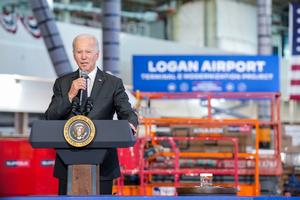Everything you need to know about Biden's bioeconomy initiative

President Biden issued an executive order in September which aims to catalyse the growth of the US bioeconomy. Herbie Lambden, Policy and Public Affairs Executive at BIA, investigates the policies and what they could mean for UK companies. Here is everything you need to know about Biden's bioeconomy intitiative.
Globally, awareness of the value of the bioeconomy is growing. Spanning manufacturing, agriculture and healthcare, biological processes offer sustainable growth and employment while also contributing to Net Zero targets.
On 12 September 2022, President Biden published an executive order setting out a National Biotechnology and Biomanufacturing Initiative (NBBI) which doubles down on the growth of the US bioeconomy. Currently valued at $950 billion, or ~5% of GDP, the Biden administration estimates that engineering biology could be used in manufacturing equivalent to one third of global output, or $30 trillion, by the end of the decade.
BIA members should pay close attention, as Biden’s initiative could shape the way governments attempt to grow their nascent bioeconomies in the 2020s, not least that of the UK.
What is an executive order?

Executive orders (EOs) are US presidential directives which coordinate a federal, ‘whole-of-government’ approach. Their rapidity made them key to the US COVID-19 response in March 2020, when President Trump declared a national emergency and reallocated medical resources.
This EO set out a 180-day timeline for federal departments to produce assessment reports and develop new policies. These policies are collectively referred to as the National Biotechnology and Biomanufacturing Initiative.
President Biden has oversight of the order, but the work of collating reports lies with the Office for Science and Technology Policy (OSTP). OSTP is directed by Dr Arati Prabhakar, formerly of US Venture Partners and DARPA. Prabhakar has a further 100 days to develop an implementation plan, due by June 2023.
What is the bioeconomy?
Biden’s EO defines the bioeconomy as ‘economic activity derived from the life sciences, particularly in the areas of biotechnology and biomanufacturing’, where biomanufacturing is ‘the use of biological systems to develop products, tools, and processes at commercial scale’. The EO covers health, energy, food security, climate change, agriculture, and more. This provides a broad platform for investment which recognises the many applications of biotech and biomanufacturing.
Why now?
The EO has both a domestic and an international impetus. The NBBI aims to ‘grow the economy across all of America’. This means regenerating regional economies beyond the existing clusters of Boston and the Bay Area, comparable to the levelling up agenda in the UK.
It also comes at a time when US concern about the growth of China’s bioeconomy is at an all-time high. Recent Chinese strategies have looked to boost the bioeconomy with targets of $1.2-1.6 trillion and 7% of GDP spent on R&D by 2025.
The CHIPS (Creating Helpful Incentives to Produce Semiconductors) and Science Act of August 2022 took aim at the growing Chinese semiconductor industry. Valued at $280 billion, the Act committed billions of dollars to scientific R&D, paving the way for the NBBI. Alongside semiconductors, the bioeconomy could become another factor in ongoing trade competition between China and the US.
How does it compare to the UK?
With $2 billion already made available, and a share of $200 billion committed to STEM R&D through the CHIPS Act, US federal investment is at the crux of the initiative. The UK is also investing in its bioeconomy, with £39.8 billion earmarked for R&D and more targeted funding available through the Net Zero Strategy.
The US is moving into innovative new areas. For example, domestic biomanufacturing and biomass production will receive support from the Departments of Agriculture and Defense worth $1.5 billion. Cross-government coordination is less evident in the UK. With no singular bioeconomy strategy in place, innovative sections of our bioeconomy risk being overlooked.
Biosecurity will be made a ‘cornerstone’ of the US bioeconomy through a new bioassurance programme. The UK Home Office is working in this increasingly important area alongside the Departments for Health and the Environment, supported by the Defence Science and Technology Laboratory (Dstl). BIA responded to a consultation on the Biological Security Strategy last year.
The NBBI also recognises the importance of boosting skills and streamlining regulation to growing the bioeconomy. The UK will need to stay apace with the FDA’s reforms and new federal technical education and training programmes to ensure that its bioeconomy can compete with that of the US.
For a comprehensive summary of the policies contained in the NBBI and the timeline for their development, read the full briefing.
Conclusion
With the policies and funding allocation of the NBBI yet to be determined, and with the Biden Administration weakened by the loss of the House in the midterms, the success of the initiative hangs in the balance. What is undeniable, however, is that this EO throws down the gauntlet in setting out the scale and ambition possible within a national bioeconomy strategy.
The UK has all the ingredients necessary for a world-leading bioeconomy. It is already home to many disruptive SMEs working in this space, as well as forward-thinking innovation, Net Zero, and biological security strategies. We now even have a Department for Science, Innovation and Technology (DSIT) that could drive this agenda forward. By emulating the cross-government working of the NBBI, the UK could confirm its status as a major player in the global bioeconomy.
Educating the public about what the bioeconomy can offer them, from cheaper food to better-paying jobs, will also play an important role. BIA and its Engineering Biology Advisory Committee will continue to inform BIA’s work to influence policymakers, helping us to move towards a more holistic understanding of the bioeconomy.
More like this
.png)
.png)